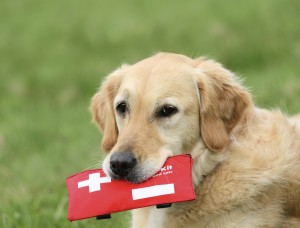Basic First Aid for Pets
 No one wants to think about a pet falling victim to accident or illness, but most of us will agree that thinking about emergency preparedness is important. The reality is: accidents happen and sudden illness or symptoms of distress can befall any pet, even the healthiest. Because of this, having a basic understanding of how to administer First Aid for pets is an important skill for any pet owner and can even save the life of a pet.
No one wants to think about a pet falling victim to accident or illness, but most of us will agree that thinking about emergency preparedness is important. The reality is: accidents happen and sudden illness or symptoms of distress can befall any pet, even the healthiest. Because of this, having a basic understanding of how to administer First Aid for pets is an important skill for any pet owner and can even save the life of a pet.
What You Will Need
Advance preparation is key in effective emergency response. If possible, keep the following first aid items in your home with your pet’s daily care supplies or in the car while travelling:
- Pet first-aid kit
- Crate or carrier lined with soft materials
- Muzzle (for protection while moving an injured or ill pet)
- Leash and collar
- Extra towels or blankets, which can be used as a stretcher
- Your pet’s medical history and veterinary contact information
Tips for Administering First Aid for Pets
Ideally, in an emergency situation you can immediately transport your pet to the nearest emergency veterinary hospital or your own veterinary clinic. However, there are times when you must first stabilize your pet or move him or her out of immediate danger (such as in the case of a car accident or dog fight). Once your pet is stable and out of harm’s way, seek emergency care right away.
When first aid is required, match your response to the injury or illness being treated. The following are recommendations on applying first aid to a range of common emergency situations:
- When an injured pet must be moved to safety, do so carefully, using a blanket, towel, or plywood as a stretcher to avoid additional injury.
- If there is external bleeding, apply gentle pressure to the wound site, using pieces of cloth or other fabric material, or even your hand.
- If administering artificial respiration, make sure the throat is free from obstructions and exhale gently through your pet’s nose, while covering his mouth. Repeat every 5-6 seconds.
- CPR can also be used in conjunction with respiration. Lay your pet on his side and apply pressure at the pulse of 70 times per minute. Use care with all pets, especially small breeds and cats, to avoid breaking ribs.
- If your pet has gone into shock, keep him warm by wrapping him in blankets while seeking emergency care.
- Heatstroke, which is common in the summer months, requires emergency care. To help lower the body temperature during transport, spray him with cool (not ice) water and surround his or her head, neck, and torso with wet towels.
- To protect your pet during a seizure, do not try to restrain. Instead, place towels and blankets around the body to prevent injury.
- If you suspect your pet has ingested a poison, do not wait for symptoms to appear – seek emergency veterinary care right away.
- Fractures and other breaks can be compounded by too much movement. If possible, keep your pet as still and calm as you are able to while transporting him in a towel lined box or crate.
For pet parents seeking more in depth first aid and CPR skills, the American Red Cross offers pet First Aid classes, as well as a downloadable app for iPhones and Androids.
The important thing to remember in all pet emergencies is that first aid is simply a means of preventing further injury or complications while in the process of seeking veterinary care. If your pet is injured, do not assume that no visible symptoms means the pet is unharmed, since internal bleeding and organ injury is difficult to notice without an examination.
Quick thinking and immediate transport to the veterinary clinic can make the difference between life and death. For more information on responding to pet emergencies, please contact us at Oakland Veterinary Referral Services.


